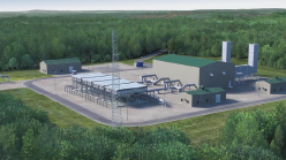During the 1990s, there was a major effort to develop, demonstrate and improve natural gas-based emission control technologies for coal-fired power plants. The two primary technologies are gas cofiring and gas reburn. The purpose of this report is to provide a review of the current status and applicability of these technologies. The report addresses gas cofiring, conventional reburn, fuel lean gas reburn, advanced gas reburn, and amine-enhanced fuel lean gas reburn. All of these technologies can provide operational benefits as well as reductions of multiple pollutants.
This report summarizes the existing information on cofiring and reburn technologies based largely on prior work sponsored by the Gas Research Institute, U.S. Department of Energy, Electric Power Research Institute, U.S. Environmental Protection Agency and state agencies. While the report attempts to put this work in today’s context it does not include any major new analysis.
Gas Cofiring
Gas cofiring is the combustion of natural gas with coal in the primary combustion zone of a boiler. The gas can be fired in ignitors, warm-up guns, or gas burners. Many coal boilers were built with this capability. These boilers can and do use gas periodically for some of the basic cofiring benefits. Cofiring is the simplest gas-based technology and has the broadest range of potential applications and benefits. Cofiring can provide emission reduction benefits as well as a variety of operational benefits. Some of these benefits can be achieved relatively easier with almost any type of gas firing. Others require more sophisticated operation and installation.
The onsite capital cost of cofiring can range from zero (if gas firing equipment is already in place) to around $6/kW if burners must be installed. In some cases, the cost of bringing gas to the site must be added to this cost. The cost of the gas itself, is the major cost factor in most applications.
Cofiring reduces emissions of SO2 and ash by displacing coal in the boiler. These emission reductions are roughly proportional to the amount of gas used, which is typically up to 20 percent. NOx emission reductions from cofiring are more site-specific and difficult to predict. At current and expected gas prices, the cost of emissions reductions created by cofiring is much higher than alternative approaches or the price of SO2 and NOx allowances in the emission trading markets.
Among the many operational benefits of cofiring, those that have the highest value are likely to be allowing coal plants to more easily burn low-sulfur coal and allowing plants to increase their peak output during times of peak demand. The latter in particular could have high value in competitive electricity markets but is intermittent and unlikely to create a large amount of gas consumption.
Gas Reburn
Gas reburn is the use of gas as a chemical reagent above the primary combustion zone to produce leveraged NOx emission reductions. Reburn can also provide a variety of other emissions and operational benefits. There are several variants of reburn with specific operational and performance benefits. The most competitive variant today seems to be fuel lean gas reburn (FLGR), which uses about 7 percent gas input to achieve 30 to 40 percent NOx reductions.
As with cofiring, the critical economic factor is the gas-coal price differential. At current gas and coal prices, FLGR cannot create NOx reductions at the current market level of $600/ton. An analysis of the potential market for NOx control under the 2004 SIP call NOx program suggests that FLGR could be competitive at a gas-coal price differential of $1.50/MMBtu (delivered gas prices of $2.50 to $3/MMBtu).





